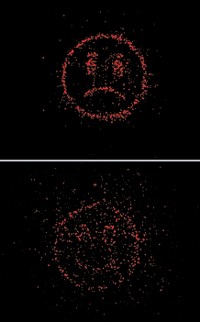Advertisement
Grab your lab coat. Let's get started
Welcome!
Welcome!
Create an account below to get 6 C&EN articles per month, receive newsletters and more - all free.
It seems this is your first time logging in online. Please enter the following information to continue.
As an ACS member you automatically get access to this site. All we need is few more details to create your reading experience.
Not you? Sign in with a different account.
Not you? Sign in with a different account.
ERROR 1
ERROR 1
ERROR 2
ERROR 2
ERROR 2
ERROR 2
ERROR 2
Password and Confirm password must match.
If you have an ACS member number, please enter it here so we can link this account to your membership. (optional)
ERROR 2
ACS values your privacy. By submitting your information, you are gaining access to C&EN and subscribing to our weekly newsletter. We use the information you provide to make your reading experience better, and we will never sell your data to third party members.
Materials
Block Copolymer Helps Lithography Get Smaller
Materials Science: Material could shrink silicon structures in computer chips, leading to fast electronics
by Melissae Fellet
April 11, 2012

A new polymer combination could help electronics manufacturers build nanoscale stamps for speedy computer chips and high-capacity hard drives. The material self-assembles into some of the smallest structures known for such polymers (ACS Nano, DOI: 10.1021/nn300459r).
To produce computer chips, manufacturers use lasers to etch patterns into polymer-covered silicon wafers, in a process known as photolithography. The smallest silicon features this method can produce are about 20 nm wide, says Craig J. Hawker, of the University of California, Santa Barbara, who was not involved with the new study. To pack more wires, transistors, and junctions onto a chip, thus producing faster electronics, chip manufacturers need to create patterns with smaller features, says Christopher J. Ellison, of the University of Texas, Austin.
Researchers have tried to produce these super small structures by using an etching template made from block copolymers. In a block copolymer, each polymer strand has two parts, or blocks, each with different physical properties. The polymers are like linking a bubble of oil to a water droplet, Ellison says. In solution, the molecules’ waterlike sections cluster into nanosized structures, surrounded by a matrix of oily plastic, created by the other polymer block. Etching away one block of the copolymer creates a pattern of tiny features for lithography.
When designing a block copolymer, researchers control the size of the etched structures in the template by changing the length of the polymer strand and adjusting the polarity difference between the two polymer parts. In general, shorter strands form smaller clumps. As the strands get shorter, researchers must increase the polarity difference between the polymer parts. If the difference isn’t large enough, the strands’ waterlike and oily blocks start to mix and the structures don’t form.
To create super small features that would easily self-assemble, Ellison, C. Grant Willson, also at UT Austin, Redouane Borsali, of Centre de Recherches sur les Macromolécules Végétales in France, and their colleagues looked to design a new copolymer that kept the strands small and maximized the polarity difference. The result was a hydrophilic strand of sugars – either maltoheptose or a branched xyloglucan – connected to a hydrophobic string of silicon-tipped polystyrene.
On a silicon wafer, the sugar strands clumped into 5-nm-wide cylinders surrounded by a matrix of polystyrene. If each sugary cylinder was a bit of information on a hard drive disk, a square inch of disk area would contain 8 terabits of information, far greater than the 1 terabit per square inch manufacturers want to produce, Ellison says.
When the researchers blasted the patterned wafer with oxygen plasma, they removed the sugar from the surface, leaving behind the polystyrene. The result is a honeycomb of cylindrical cavities that could be used in subsequent chip production steps.
UC Santa Barbara’s Hawker applauds the researcher’s design strategy for the copolymer. “It’s a wonderful first step towards future potential commercialization” of copolymer lithography, he says.
One of the next challenges is to control the pattern formed during the polymers’ self-assembly, Hawker adds.



Join the conversation
Contact the reporter
Submit a Letter to the Editor for publication
Engage with us on Twitter